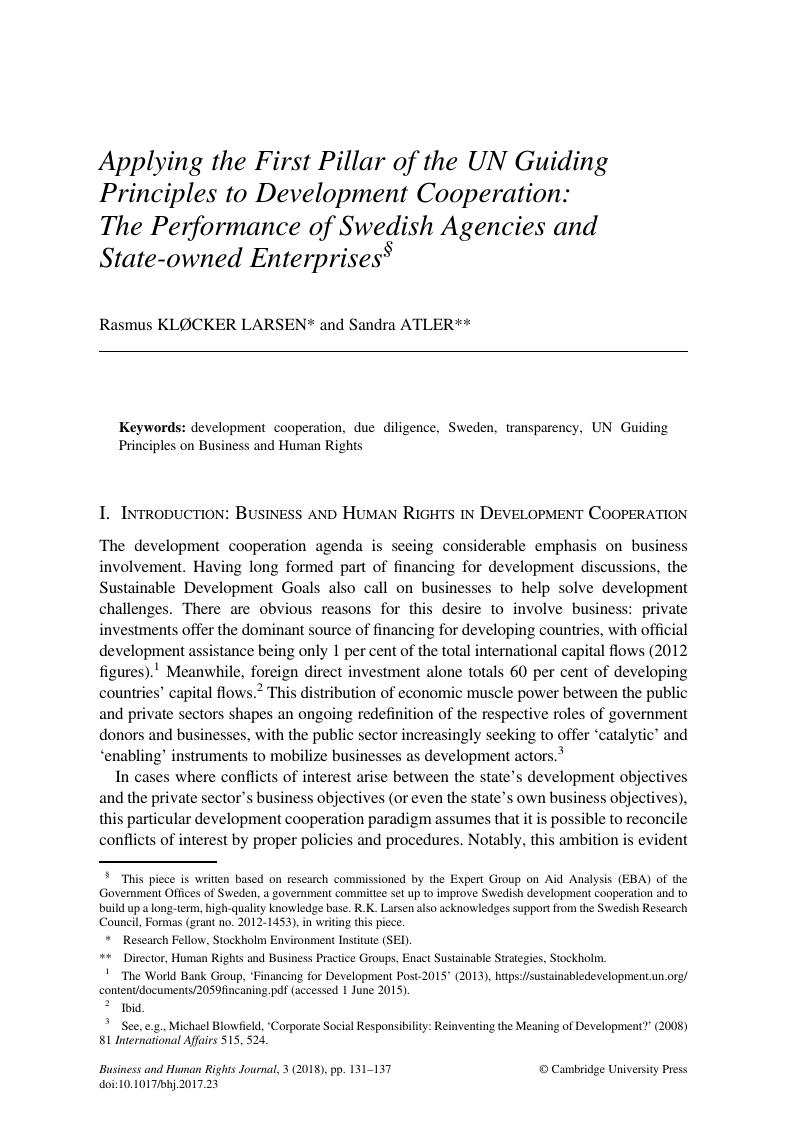No CrossRef data available.
Article contents
Applying the First Pillar of the UN Guiding Principles to Development Cooperation: The Performance of Swedish Agencies and State-owned Enterprises
Published online by Cambridge University Press: 30 October 2017
Abstract

Keywords
- Type
- Developments in the Field
- Information
- Copyright
- Copyright © Cambridge University Press
Footnotes
This piece is written based on research commissioned by the Expert Group on Aid Analysis (EBA) of the Government Offices of Sweden, a government committee set up to improve Swedish development cooperation and to build up a long-term, high-quality knowledge base. R.K. Larsen also acknowledges support from the Swedish Research Council, Formas (grant no. 2012-1453), in writing this piece.
Research Fellow, Stockholm Environment Institute (SEI).
Director, Human Rights and Business Practice Groups, Enact Sustainable Strategies, Stockholm.
References
1 The World Bank Group, ‘Financing for Development Post-2015’ (2013), https://sustainabledevelopment.un.org/content/documents/2059fincaning.pdf (accessed 1 June 2015).
2 Ibid.
3 See, e.g., Blowfield, Michael, ‘Corporate Social Responsibility: Reinventing the Meaning of Development?’ (2008) 81 International Affairs 515, 524 Google Scholar.
4 OECD ‘Synthesis Report on Policy Coherence for Development’ (2008), COM/SG/DCD(2008)1/REV1.
5 Carbone, Maurizio, ‘Mission Impossible: The European Union and Policy Coherence for Development’ (2008) 30:3 European Integration 323 CrossRefGoogle Scholar, 342; Larsen, Rasmus K and Powell, N, ‘Policy Coherence for Sustainable Agricultural Development: Uncovering Prospects and Pretense within the Swedish Policy for Global Development’ (2013) 31:6 Development Policy Review 757 CrossRefGoogle Scholar, 776.
6 Human Rights Council, ‘Guiding Principles on Business and Human Rights: Implementing the United Nations “Protect, Respect and Remedy” Framework, A/HCR//17/31 (21 March 2011).
7 Ruggie, John, Just Business: Multinational Corporations and Human Rights (London: W Norton and Company Ltd, 2013) 172 Google Scholar.
8 Larsen, Rasmus K and Atler, Sandra, Business and Human Rights in Development Cooperation – Has Sweden Incorporated the UN Guiding Principles? (2015)Google Scholar, http://eba.se/wp-content/uploads/2016/01/Report08.pdf (accessed 8 September 2017).
9 Human Rights Commission, ‘Human Rights and Transnational Corporations and Other Business Enterprises’, Resolution 2005/69 (20 April 2005).
10 For more on the responsibilities of SOEs, see Human Rights Council, ‘Report of the Working Group on the Issue of Human Rights and Transnational Corporations and Other Business Enterprises’, A/HRC/32/45 (18 April 2016).
11 For details, see Larsen and Atler, note 8.
12 Human Rights Council, note 10.
13 Larsen and Atler, note 8.
14 Ministry of Enterprise and Innovation, ‘Sveriges mineralstrategi – För ett hållbart nyttjande av Sveriges mineraltillgångar som skapar tillväxt i hela landet’ (2013).
15 This is reflected in the review of steering documents from the relevant ministry for all five agencies/companies, none of which mention HRDD.
16 Interview with an agency representative: Larsen and Atler, note 8, 52.
17 This was evident from the document review; no steering documents or reports demonstrated systematic monitoring. For instance, SIDA has been given the assignment to formulate and report on indicators related to some of the sub-objectives in the Aid Policy Framework, although not specifically regarding business and human rights.
18 See Tryckfrihetsförordningen (SFS 1949:105), 2nd chapter. Exception to this rule is outlined in Offentlighets och sekretesslagen (SFS 2009:400). The Swedish Aid Policy Framework (2014) also places particular emphasis on the so-called ‘transparency guarantee’ in Swedish development cooperation.
19 Email correspondence with SOE representative: Larsen and Atler, note 7, 64. Moreover, it was noteworthy that in the private sector partnerships, SIDA allows partner companies to place confidentiality clauses in the due diligence assessments – a mechanism most of the collaborating companies use. Email correspondence with SIDA staff, as cited in Larsen and Atler, note 7, 46.
20 See Addo, Michael K, ‘The Reality of the United Nations Guiding Principles on Business and Human Rights’ (2014) 14 Human Rights Law Review 133, 147 CrossRefGoogle Scholar.
21 Government Offices of Sweden, ‘Action Plan for Business and Human Rights’ (2015), http://www.government.se/press-releases/2015/08/swedens-national-action-plan-for-business-and-human-rights-to-support-swedish-exports/ (accessed 1 September 2015).
22 See McGee, Rosemary, ‘Aid Transparency and Accountability: “Build It and They’ll Come”’? (2013) 31:1 Development Policy Review 107 CrossRefGoogle Scholar, 124.
23 Ruggie, Just Busines, note 7.




